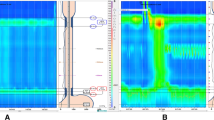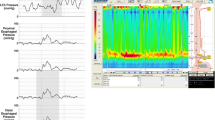Abstract
Although hiatal hernia is reported with a 40–50% frequency in the general population, its occurrence and potential implications in achalasia are less well known. We reviewed the medical records and radiographic examinations of 120 patients with achalasia to assess the prevalence of hiatal hernia and its importance in evaluation and management of this motility disorder. Hiatal hernia was present in only 10 (8.3%) patients. Age, sex distribution, prevalence of dysphagia and regurgitation, and lower esophageal sphincter pressure measured manometrically were not significantly different in patients having hiatal hernia compared to those without hernia. Most patients (88%) underwent pneumatic dilatation and five esophageal perforations occurred, but all in patients without hiatal hernia. In conclusion, hiatal hernia is uncommon in patients with achalasia for reasons not known. Age, sex, symptoms, and results of esophageal manometry were not significantly different in those with hiatal hernia. Finally, the presence of hiatal hernia is not a contraindication to treatment of achalasia by pneumatic dilatation.
Similar content being viewed by others
References
Cohen S, Harris LD. Does hiatus hernia affect competence of the gastroesophageal sphincter? N Engl J Med 1971;284:1053–1056
Ott DJ, Wu WC, Gelfand DW. Reflux esophagitis revisited: prospective analysis of radiologic accuracy. Gastrointest Radiol 1981;6:1–7
Ott DJ, Gelfand DW, Chen YM, Wu WC, Munitz HA. Predictive relationship of hiatal hernia to reflux esophagitis. Gastrointest Radiol 1985;10:317–320
Ott DJ, Richter JE, Chen YM, Wu WC, Gelfand DW, Castell DO. Esophageal radiography and manometry: correlation in 172 patients with dysphagia. AJR 1987;149:307–311
Ott DJ, Donati D, Wu WC, Chen MYM, Gelfand DW. Radiographic evaluation of achalasia immediately after pneumatic dilatation with the Rigiflex dilator. Gastrointest Radiol 1991;16:279–282
Olsen AM, Holman CB, Andersen HA. The diagnosis of cardiospasm. Dis Chest 1953;23:477–498
Palmer ED. Achalasia: anatomy of cardia as it relates to regional pathophysiology. Radiology 1956;67:79–83
Okike N, Payne WS, Neufeld DM, Bernatz PE, Pairolero PC, Sanderson DR. Esophagomyotomy versus forceful dilation for achalasia of the esophagus: results in 899 patients. Ann Thorac Surg 1979;28:119–123
Zelter R, Chiocca JC, Salis B, Mazure PA. Patologia esofagica asociada a la acalasia. Acta Gastroent Lat Am 1982;12:23–32
Taub W, Achkar E. Hiatal hernia in patients with achalasia. Am J Gastroenterol 1987;82:1256–1258
Author information
Authors and Affiliations
Rights and permissions
About this article
Cite this article
Ott, D.J., Hodge, R.G., Chen, M.Y.M. et al. Achalasia associated with hiatal hernia: Prevalence and potential implications. Abdom Imaging 18, 7–9 (1993). https://doi.org/10.1007/BF00201690
Received:
Accepted:
Issue Date:
DOI: https://doi.org/10.1007/BF00201690




